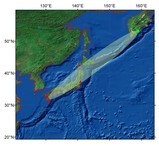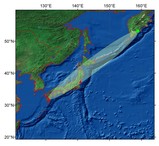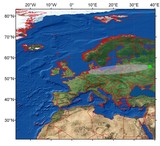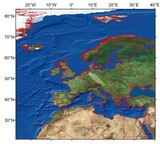VLF-DATA
The research of VLF/LF (20-50 kHz) signals associated with earthquakes started in Russia in 1987. In a frame of Frontier project (1996-2001) several OmniPal receivers were installed in Japan. In 2000 in cooperation with Japaneese colleagues the OmniPal receiver has been put into operation in Petropavljvsk-Kamchatsky. In 2009 new UltraMSK receivers were installed in Yuzhno-Sakhalinsk and Moscow and in 2011 in Yuzhno-Kurilsk. In Europe such research started in 2002 in Bari (Italy). At present several receives operate in Europe - in Graz (Austria), Greece, Romania, Turkey, Central Italy and Portugal. In 2013 the UltraMSK receiver has been instaled in Sheffield (the UK).
The investigation is intended for the search of localized disturbances in low ionosphere associated with seismic activity (earthquakes, tsunamis, volcano eruptions) in comparison with the global perturbations related to the atmosphere circulation, magnetic storms and substorms and solar activity. The main goal of the work is the development of short-term forecasting methods based on observation of VLF/LF signals from powerful navigational and time service transmitters deployed in Europe, Asia, USA, and Australia.
Modern software in new generation of the VLF/LF received installed recently provides on line access to data through Internet that allows developing a real-time warning system.
The regular many years monitoring in the Far East network and Bari station revealed pre and post seismic effects in VLF radio signals, when a wave path is near enough to the epicentres of earthquakes. The seismic related phase and amplitude anomalies were observed in the interval from one week before an earthquake to one week afterwards. The most significant result has been obtained from observation in three European VLF/LF stations - Moscow, Bari and Graz - for earthquake in L'Aquila (Italy) April 6, 2009. Strong nighttime anomalies for long propagation paths together with shift of evening Terminator for short paths have been found 5-6 days befor the earthquake. Direction finding research has showed excellent coincidence with real position of the earthquake epicenter.
A network of VLF receivers, sited in the Far East, at first time has been used to observe the response of the lower ionosphere to tsunamis resulting from the November 15, 2006 (Kuril region) and the March 11, 2011 (Tohoku region) earthquakes. Specific perturbations in the phase and amplitude of VLF signals have been found for both cases. A qualitative interpretation of the observed effects was suggested in terms of the interaction of internal gravity waves with the lower ionosphere.
The scientific objectives of the researcg are as follows:
1. Identification of reliable signatures of the preparatory phases of earthquakes in temporal and spatial variations of the signal parameters obtained from multi-station VLF/LF measurements.
2. Diagnostic of seismicity from DEMETER database over Europe and Far East and correlation satellite anomalies above seismo-active regions with ground VLF observations.
3. Theoretical modeling of the interaction processes and the transfer mechanisms in the lithosphere-atmosphere-ionosphere system.
The research had been supported by ISTC project 1121 and 2990, RFBR 02-05-64069 and t is now supported by Seventh Framework Programme FP7 under grant agreement n°262005 SEMEP and RFBR 11-05-00155-à and 13-05-92602 KO_a.
VLF Station P-Kamchatsky
VLF Station Yuzhno-Sakhalinsk
VLF Station Moscow
VLF Station GRAZ



